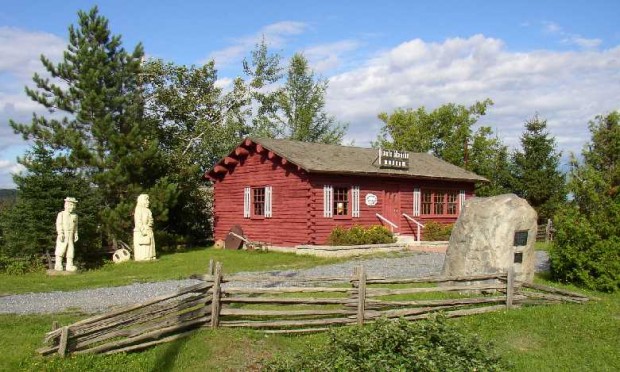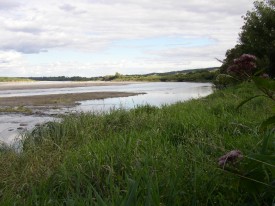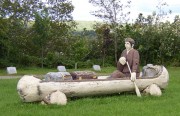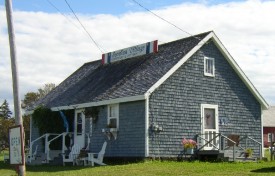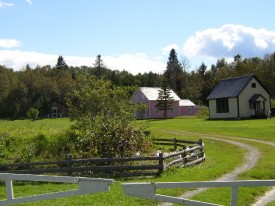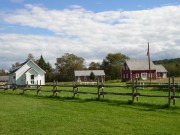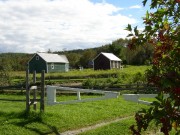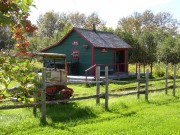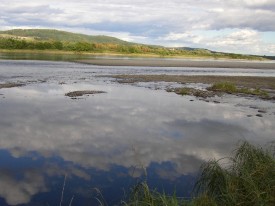
Acadian Landing Site in Madawaska (2003)
Originally a French colony, Acadian lands in the Annapolis Valley of Nova Scotia were passed back and forth between the French and English by various treaties settling European wars. The last of these, the Treaty of Utrecht in 1713, gave the land to England.
For a time the Acadians lived peacefully with the English. In fact, the period from 1730 to 1748 has been called the Golden Age of the Acadians. Their farms prospered and their population grew from 2,300 in 1714 to over 13,000 by mid-century.
Many of the first Acadians came from an area in the west of France where they had learned to build dikes and drain salt marshes. They used these skills to drain tidal flats around the Bay of Fundy, creating very fertile farmland. Their coastal farming activities did not interfere with the fishing and hunting culture of the local Micmac Indians, with whom the Acadians enjoyed good relations.
During English rule, the Acadians maintained a careful neutrality. They would not fight with the French, they promised, but neither would they fight against them. They refused to sign any oath of allegiance to the King of England who required them to take up arms against the French. Initially the English did not press the point and the Acadians felt their neutrality was accepted, but then war broke out again between England and France.
Then Governor Cornwallis threatened deportation if the Acadians wouldn’t sign the oath. When Governor Lawrence replaced him in 1754, those threats were carried out. The expulsion of the Acadians was quick and cruel. Beginning in 1755 they were herded onto ships and dispersed down the coast to English colonies in the south. Families were split and more than a third were lost at sea or died of disease. Some made it to Louisiana where they created the Cajun culture.
Others escaped by fleeing to the mouth of the St. John river and then up that river to hide from the English. The sculpture at right (located in Madawaska) depicts an Acadian refugee escaping with his possessions in a dugout canoe.
Marguerite Cyr, a healer, midwife, and pioneer, was among was part of the migration from the French settlements of Acadia to the St. John River Valley.
Seeking a place where the English fleet could not penetrate, they came to Grand Falls, twelve miles south of where the town of Van Buren is now located. Safe now from the British ships, they continued farther in search of a place to settle. Arriving at the great flats near present day Madawaska, the Acadian exiles established their community on both side of the river.
Just west of downtown in Van Buren on U.S. Route 1, one may visit The Acadian Village, consisting of replica buildings in the style of the early Acadians. A “country store and gift shop” is adjacent to the village.
From Madawaska, other Acadian settlements spread up and down the river. The St. John Valley area of Maine in northern Aroostook County is now home to the descendants of these early refugees from persecution.
The origin of the name “Acadia” is not clear. The U.S. Geological Survey in a 1905 publication* said, it is “named from Acadia, the original name of Nova Scotia. The
word is the French form of the Indian word akadi, ” where there is,” “where there are,” ” where are found.”
Brian McCauley offers “Some say it comes from the Abenaki or Micmac word ‘quoddy’ meaning place. [Or] that it comes from the ‘aquoddy’ in Passamaquoddy.”
Additional resources
*See Glossary, source number 7.
Acadian Archives, University of Maine, Fort Kent. Acadian Villages, Acadian History. (moving images)
A Country by Consent. West-Dunn Publications. 1998.
Baxter, James Phinney. What Caused the Deportation of the Acadians? [microform] Worcester, Mass. C. Hamilton. 1899. (Orono. University of Maine Microforms)
Brebner, John Bartlet. New England’s Outpost: Acadia Before the Conquest of Canada. New York. B. Franklin. 1974.
Clarke, George Frederick. Expulsion of the Acadians: The True Story, Documented. Fredericton, N.B. Brunswick Press. 1977, c1955.
Collins, Charles W. The Acadians of Madawaska, Maine. Boston. T. A. Whalen. 1902.
Doty, C. Stewart. Acadian Hard Times: The Farm Security Administration in Maine’s St. John Valley, 1940-1943. Orono, Me. University of Maine Press. 1991, 1996.
Doty, C. Stewart. C. Stewart Doty Photograph Collection, 1941-1989. 220 black and white photographs taken by John Collier Jr. and Jack Delano for the Farm Security Administration in 1941-42, and by Jack Walas in 1989. Collected for use in Doty’s publication Acadian Hard Times. [Acadian Archives, University of Maine, Fort Kent.]
Du Grand Dérangement à la Déportation: nouvelles perspectives historiques. Sous la direction de Ronnie-Gilles LeBlanc. Moncton, NB. Chaire d’études acadiennes, Université de Moncton. 2005.
McCauley, Brian. The Names of Maine. Wellesley, Ma. Acadia Press. 2004.
Michaud, A. J. An Acadian Heritage from the St. John River Valley. Madawaska, Me. Valley Publishing Co. 1972.
Starkey, Glenn Wendell. Maine: Its History, Resources, and Government. Boston, New York, etc. Silver, Burdett and Company. c1938.
Webster, John Clarence, 1863-1950. Acadia at the end of the seventeenth century; letters, journals and memoirs of Joseph Robineau de Villebon, commandant in Acadia, 1690-1700, and other contemporary documents. Saint John, N.B. The New Brunswick Museum. 1934.



